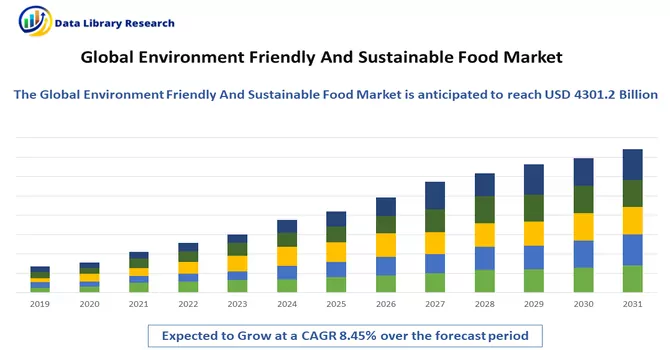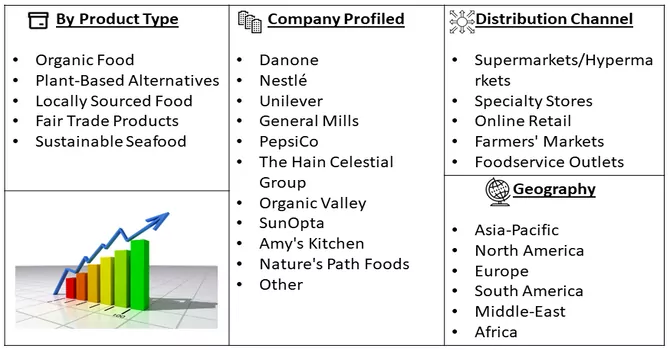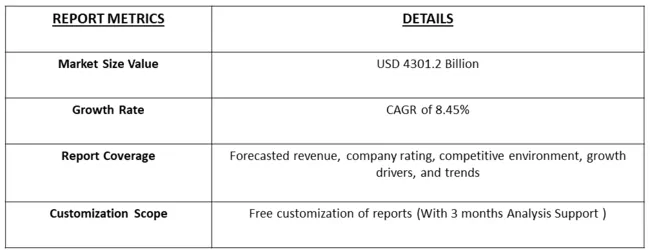The global environment friendly and sustainable food market was valued at USD 4301.2 Billion in 2023 and growing at a CAGR of 8.45% from 2024 to 2031.

Get Complete Analysis Of The Report - Download Free Sample PDF
The global market for environment friendly and sustainable food is experiencing a notable surge in demand as consumers increasingly prioritize ethical and eco-conscious choices. With growing awareness of the environmental impact of food production, consumers are seeking products that align with sustainability goals, encompassing organic farming practices, reduced carbon footprints, and ethical sourcing. This market is witnessing a rise in plant-based alternatives, as consumers shift towards more sustainable and cruelty-free diets. Companies are responding by incorporating eco-friendly packaging, promoting responsible supply chains, and adopting transparent labeling practices to meet the evolving preferences of environmentally conscious consumers. Regulatory initiatives and certifications emphasizing sustainability further contribute to shaping this market, encouraging both producers and consumers to actively participate in fostering a more environment friendly and sustainable food ecosystem.
The growth of the global environment friendly and sustainable food market is propelled by a combination of consumer awareness, regulatory support, and industry initiatives. Increasing consciousness among consumers regarding the environmental impact of food production and the desire for healthier, sustainable options drive the demand for eco-friendly and ethically sourced products. Governments and regulatory bodies worldwide are endorsing sustainability through policies, certifications, and incentives, encouraging businesses to adopt environmentally responsible practices. Additionally, industry players are investing in research and development to innovate sustainable farming methods, reduce carbon footprints, and introduce eco-friendly packaging solutions. The collaborative effort between consumers, regulatory bodies, and businesses fosters a conducive environment for the continued expansion of the global market for environment friendly and sustainable food.
Market Segmentation: The Global Environment Friendly and Sustainable Food Market segmented by Product Type: (Organic Food, Plant-Based Alternatives, Locally Sourced Food, Fair Trade Products and Sustainable Seafood), Distribution Channel: (Supermarkets/Hypermarkets, Specialty Stores, Online Retail, Farmers' Markets and Foodservice Outlets) and Geography (North America, Europe, Asia Pacific, Middle East and Africa, and South America). The market provides the value (in USD million) for the above-mentioned segments.

For Detailed Market Segmentation - Download Free Sample PDF
The global market for environment friendly and sustainable food is witnessing several notable trends. A significant trend is the rising demand for plant-based and alternative protein products as consumers increasingly adopt flexitarian and vegetarian diets to reduce their environmental impact. Sustainable packaging solutions, such as compostable and biodegradable materials, are gaining prominence as consumers seek eco-friendly options. Additionally, there is a growing emphasis on food traceability and transparency, with consumers showing interest in understanding the sourcing and production practices of the food they consume. The circular economy concept is influencing the industry, leading to initiatives that minimize food waste and promote recycling. These trends underscore a shift towards more ethical and sustainable practices in the food industry, aligning with the preferences of environmentally conscious consumers.
Market Drivers:
Increasing Consumer Awareness and Demand:
There is a growing global awareness of environmental issues, climate change, and the impact of traditional food production on ecosystems. Consumers are becoming more conscious of their food choices, seeking products with lower carbon footprints, ethical sourcing, and sustainable farming practices. The demand for organic, locally sourced, and plant-based food options is on the rise as consumers prioritize environment friendly alternatives.
Regulatory Support and Industry Initiatives:
Governments and regulatory bodies worldwide are implementing policies and regulations to promote sustainable agriculture and reduce the environmental impact of food production. Subsidies, incentives, and certifications for sustainable farming practices encourage food producers to adopt eco-friendly methods. Additionally, industry stakeholders, including major food corporations, are taking proactive measures to incorporate sustainability into their supply chains, product development, and marketing strategies to meet the growing demand for environment responsible food options.
Market Restraints:
Higher Cost of Sustainable Practices:
Implementing environment friendly and sustainable farming practices often requires significant investments in technology, certifications, and alternative production methods. These practices can lead to higher production costs, making sustainable food products more expensive for consumers. The affordability factor becomes a potential barrier for a broader consumer base, as cost-sensitive markets may be reluctant to choose sustainable options over conventional alternatives. Striking a balance between sustainability and cost-effectiveness remains a key challenge for the industry, hindering the widespread adoption of eco-friendly practices in the food supply chain. Efforts to address this challenge involve innovations in sustainable technologies, economies of scale, and continued consumer education about the long-term benefits of supporting environment friendly food choices.
The global COVID-19 pandemic has significantly impacted the landscape of the environment friendly and sustainable food market. The crisis has underscored the vulnerabilities in supply chains and highlighted the importance of resilience and adaptability. During the initial phases of the pandemic, disruptions in logistics and transportation posed challenges to the distribution of sustainable food products. Lockdowns and restrictions on movement affected the ability of consumers to access these products, leading to shifts in purchasing behavior.On the production side, some sustainable farming practices faced disruptions due to labor shortages and uncertainties in the availability of essential resources. However, the pandemic has also acted as a catalyst for increased awareness about the link between food choices, health, and the environment. Consumers have shown a growing interest in supporting sustainable and local food systems, driven by concerns for personal well-being and the desire to contribute to a more resilient and eco-friendly food supply. As the world recovers from the pandemic, the lessons learned are likely to shape a more robust and sustainable future for the global environment friendly and sustainable food market. The industry is poised to capitalize on this increased awareness and leverage innovative solutions to address challenges exposed by the pandemic.
Segmental Analysis:
Fair trade products and sustainable seafood is Expected to Witness Significant Growth Over the Forecast Period
Fair trade products and sustainable seafood are integral components of the global market for environment friendly and sustainable food. Fair trade practices ensure equitable compensation and working conditions for producers, while sustainable seafood sourcing aims to minimize the environmental impact of fishing practices. Together, they represent key pillars of ethical and responsible consumption in the food industry. The demand for fair trade products and sustainable seafood has been steadily growing worldwide as consumers become more aware of the social and environmental implications of their purchasing decisions. Additionally, regulatory frameworks and certifications such as Fair Trade International and Marine Stewardship Council (MSC) play a crucial role in promoting and verifying the authenticity of these products. As a result, fair trade products and sustainable seafood contribute significantly to the overall growth and development of the environment friendly and sustainable food market on a global scale.
Supermarkets/Hypermarkets is Expected to Witness Significant Growth Over the Forecast Period
Supermarkets and hypermarkets play a pivotal role in the global market for environment friendly and sustainable food. With their wide reach and extensive consumer base, these retail outlets serve as critical channels for distributing sustainable food products to a mass audience. Many supermarkets and hypermarkets have recognized the growing consumer demand for environment friendly and sustainable food options and have responded by expanding their offerings in this segment. They often collaborate with suppliers and manufacturers to source eco-friendly products and promote sustainable farming practices. Additionally, supermarkets and hypermarkets leverage their marketing and advertising capabilities to raise awareness about the importance of sustainable food consumption and educate consumers about the environmental benefits of choosing such products. As a result, they contribute significantly to driving the growth of the global market for environment friendly and sustainable food by making these products more accessible and mainstream for consumers worldwide.
North America Region is Expected to Witness Significant Growth Over the Forecast Period
The North American market for environment friendly and sustainable food is a significant segment within the global landscape. With a growing emphasis on health consciousness, environmental sustainability, and ethical consumption, the demand for such products has been steadily increasing in North America. Consumers in this region are increasingly seeking out organic, natural, and sustainably produced food items, driving growth in the market. Moreover, regulatory initiatives and certifications promoting sustainable agriculture and food production further support the expansion of this market. Additionally, the influence of consumer preferences and purchasing habits in North America often extends to the global market, making it a crucial region for the environment friendly and sustainable food industry on a global scale. As a result, key players in this market often target North America due to its sizable consumer base and strong demand for sustainable food products.

Get Complete Analysis Of The Report - Download Free Sample PDF
The analyzed market exhibits a high degree of fragmentation, primarily attributable to the presence of numerous players operating on both a global and regional scale. The competitive landscape is characterized by a diverse array of companies, each contributing to the overall market dynamics. This fragmentation arises from the existence of specialized solution providers, established industry players, and emerging entrants, all vying for market share. The diversity in market participants is underscored by the adoption of various strategies aimed at expanding the company presence. On a global scale, companies within the studied market are strategically positioning themselves through aggressive expansion initiatives. This often involves entering new geographical regions, targeting untapped markets, and establishing a robust global footprint. The pursuit of global expansion is driven by the recognition of diverse market opportunities and the desire to capitalize on emerging trends and demands across different regions. Simultaneously, at the regional level, companies are tailoring their approaches to align with local market dynamics. Regional players are leveraging their understanding of specific market nuances, regulatory environments, and consumer preferences to gain a competitive edge. This regional focus allows companies to cater to the unique needs of local clientele, fostering stronger market penetration. To navigate the complexities of the fragmented market, companies are implementing a range of strategies. These strategies include investments in research and development to stay at the forefront of technological advancements, mergers and acquisitions to consolidate market share, strategic partnerships for synergies, and innovation to differentiate products and services. The adoption of such multifaceted strategies reflects the competitive nature of the market, with participants continually seeking avenues for growth and sustainability. In essence, the high fragmentation in the studied market not only signifies the diversity of players but also underscores the dynamism and competitiveness that drive ongoing strategic maneuvers. As companies explore various avenues for expansion, the market continues to evolve, presenting both challenges and opportunities for industry stakeholders.
Some of the key market players are:
Recent Development:
1) In March 2023, Conagra Brands, Inc. demonstrated progress on its environmental priorities, such as addressing climate change, sustainable packaging, and promoting regenerative agriculture. The company also emphasized its commitment to supporting the communities in which it operates throughout 2022. These efforts were highlighted in the company's 2022 Citizenship Report, which was recently released.
2) In June 2022, in honor of World Environment Day on June 5th, Conagra Brands (NYSE: CAG) announced the recipients of its annual Sustainable Development Awards. This employee-led program encourages the development and implementation of innovative ideas that promote sustainable production and business practices.
Q1. What was the Environment Friendly And Sustainable Food Market size in 2023?
As per Data Library Research the global environment friendly and sustainable food market was valued at USD 4301.2 Billion in 2023.
Q2. At what CAGR is the Environment Friendly And Sustainable Food market projected to grow within the forecast period?
Environment Friendly And Sustainable Food Market is growing at a CAGR of 8.45% over the forecast period.
Q3. What are the factors on which the Environment Friendly And Sustainable Food market research is based on?
By Product Type, By Distribution Channel And Geography are the factors on which the Environment Friendly And Sustainable Food market research is based.
Q4. What are the factors driving the Environment Friendly And Sustainable Food market?
Key factors that are driving the growth include the Increasing Consumer Awareness and Demand and Regulatory Support and Industry Initiatives.
Data Library Research are conducted by industry experts who offer insight on industry structure, market segmentations technology assessment and competitive landscape (CL), and penetration, as well as on emerging trends. Their analysis is based on primary interviews (~ 80%) and secondary research (~ 20%) as well as years of professional expertise in their respective industries. Adding to this, by analysing historical trends and current market positions, our analysts predict where the market will be headed for the next five years. Furthermore, the varying trends of segment & categories geographically presented are also studied and the estimated based on the primary & secondary research.
In this particular report from the supply side Data Library Research has conducted primary surveys (interviews) with the key level executives (VP, CEO’s, Marketing Director, Business Development Manager and SOFT) of the companies that active & prominent as well as the midsized organization
FIGURE 1: DLR RESEARH PROCESS

Extensive primary research was conducted to gain a deeper insight of the market and industry performance. The analysis is based on both primary and secondary research as well as years of professional expertise in the respective industries.
In addition to analysing current and historical trends, our analysts predict where the market is headed over the next five years.
It varies by segment for these categories geographically presented in the list of market tables. Speaking about this particular report we have conducted primary surveys (interviews) with the key level executives (VP, CEO’s, Marketing Director, Business Development Manager and many more) of the major players active in the market.
Secondary ResearchSecondary research was mainly used to collect and identify information useful for the extensive, technical, market-oriented, and Friend’s study of the Global Extra Neutral Alcohol. It was also used to obtain key information about major players, market classification and segmentation according to the industry trends, geographical markets, and developments related to the market and technology perspectives. For this study, analysts have gathered information from various credible sources, such as annual reports, sec filings, journals, white papers, SOFT presentations, and company web sites.
Market Size EstimationBoth, top-down and bottom-up approaches were used to estimate and validate the size of the Global market and to estimate the size of various other dependent submarkets in the overall Extra Neutral Alcohol. The key players in the market were identified through secondary research and their market contributions in the respective geographies were determined through primary and secondary research.
Forecast Model
